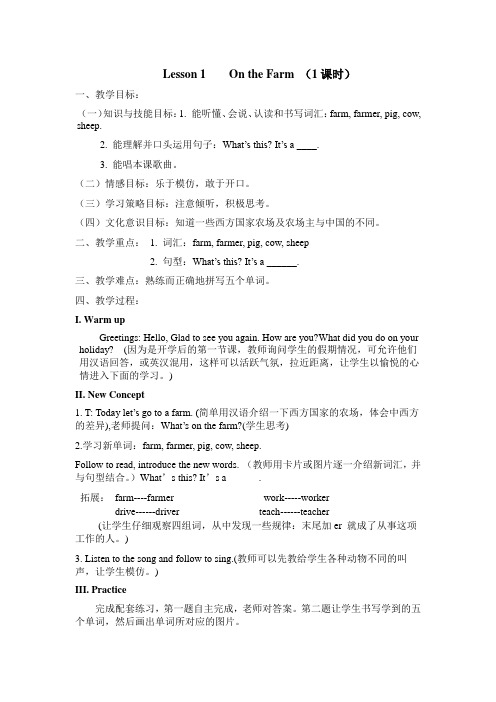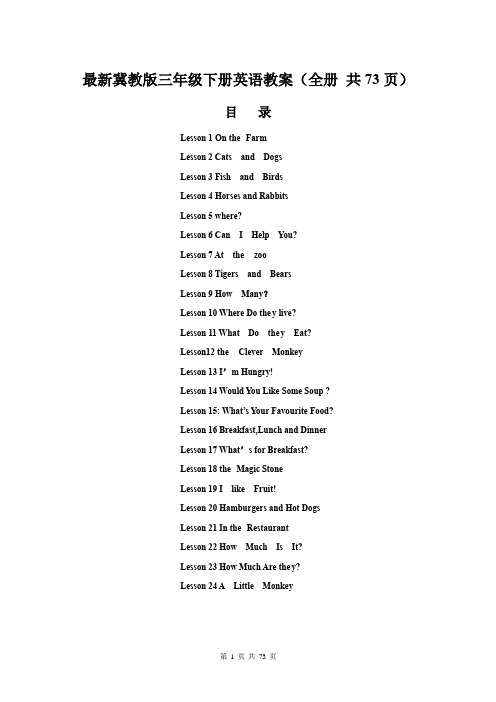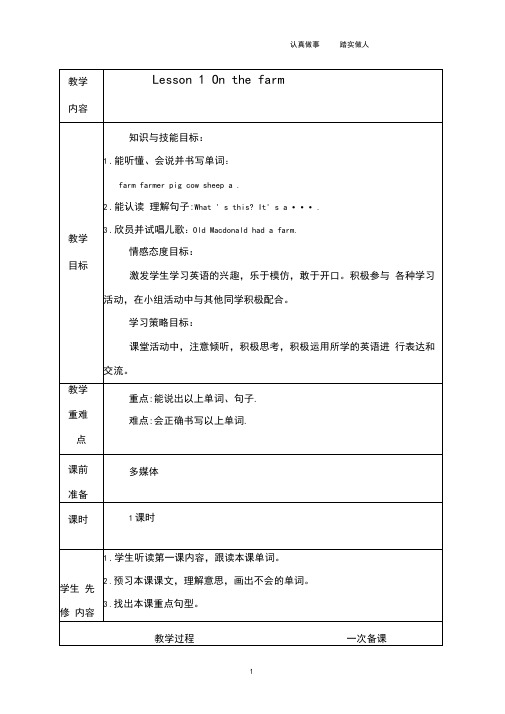2016最新冀教版三年级下册英语教案-完
- 格式:doc
- 大小:336.00 KB
- 文档页数:57

Lesson 1 On the Farm (1课时)一、教学目标:(一)知识与技能目标:1. 能听懂、会说、认读和书写词汇:farm, farmer, pig, cow, sheep.2. 能理解并口头运用句子:What’s this? It’s a ____.3. 能唱本课歌曲。
(二)情感目标:乐于模仿,敢于开口。
(三)学习策略目标:注意倾听,积极思考。
(四)文化意识目标:知道一些西方国家农场及农场主与中国的不同。
二、教学重点: 1. 词汇:farm, farmer, pig, cow, sheep2. 句型:What’s this? It’s a ______.三、教学难点:熟练而正确地拼写五个单词。
四、教学过程:I. Warm upGreetings: Hello, Glad to see you again. How are you?What did you do on your holiday? (因为是开学后的第一节课,教师询问学生的假期情况,可允许他们用汉语回答,或英汉混用,这样可以活跃气氛,拉近距离,让学生以愉悦的心情进入下面的学习。
)II. New Concept1. T: Today let’s go to a farm. (简单用汉语介绍一下西方国家的农场,体会中西方的差异),老师提问:What’s on the farm?(学生思考)2.学习新单词:farm, farmer, pig, cow, sheep.Follow to read, introduce the new words. (教师用卡片或图片逐一介绍新词汇,并与句型结合。
)What’s this? It’s a ______.拓展:farm----farmer work-----workerdrive------driver teach------teacher(让学生仔细观察四组词,从中发现一些规律:末尾加er 就成了从事这项工作的人。

最新冀教版三年级下册英语教案(全册共73页)目录Lesson 1 On the FarmLesson 2 Cats and DogsLesson 3 Fish and BirdsLesson 4 Horses and RabbitsLesson 5 where?Lesson 6 Can I Help You?Lesson 7 At the zooLesson 8 Tigers and BearsLesson 9 How Many?Lesson 10 Where Do they live?Lesson 11 What Do they Eat?Lesson12 the Clever MonkeyLesson 13 I’m Hungry!Lesson 14 Would You Like Some Soup ?Lesson 15: What’s Your Favourite Food?Lesson 16 Breakfast,Lunch and DinnerLesson 17 What’s for Breakfast?Lesson 18 the Magic StoneLesson 19 I like Fruit!Lesson 20 Hamburgers and Hot DogsLesson 21 In the RestaurantLesson 22 How Much Is It?Lesson 23 How Much Are the y?Lesson 24 A Little MonkeyLesson 1 On the Farm一. 教学目标:知识目标:1.能正确地听、说、读、写农场中的动物单词farm ,farmer ,pig,cow,sheep,a.2.能综合运用所学的语句进行交际。
—What’s this?—It’s a …二. 能力目标:通过活动培养学生能够运用所复习的词汇和句子来正确表达周围的具体实物。

三年级英语教案Lesson 1教学设计Step 1定向:1. 能听懂、会说、认读和书写词汇:farm, farmer, pig, cow, sheep2. 能理解并口头运用句子:What’s this? It’s a ______.3. 能唱本课歌曲。
4. 乐于模仿,敢于开口。
5. 注意倾听,积极思考。
Step 2自学:本课所认识的单词Step 3交流:1.T: Today let’s go to a farm. (简单用汉语介绍一下西方国家的农场,体会中西方的差异)观看教学光盘,思考What’s on the farm?Watch again, follow to read, introduce the new words. (教师用卡片或图片逐一介绍新词汇,并与句型结合。
)What’s this? It’s a ______.farm----farmer work-----workerdrive------driver teach------teacher(让学生仔细观察四组词,从中发现一些规律:末尾加er 就成了从事这项工作的人。
) pig, big, sit, sixcow, how, nowsheep, three, knee, feel(让学生试着读这些词,体会划线部分的发音,简单了解一些字母的发音及字母组合的拼读规则。
)2.T:What color is the pig/ cow/ sheep?S: It’s _______.T: black sheep 害群之马T: What animal do you like? pig, cow or sheep, why?(学生可以用汉语回答为什么,这样使交流更真实更有意义,)1.Listen to the song and follow to sing.(教师可以先教给学生各种动物不同的叫声,让学生模仿。
)Step 4答疑:1.回答问题,What’s on the farm?2. What do you see?Step 5检测:Point to the words:五张单词卡片贴到黑板上,男女生比赛,各派代表听老师指令,看谁最快指出来。

冀教版小学三年级英语下册全册教案Lesson 1 I’m Hungry!一、教学目标:知识目标1、要求学生掌握下列单词eat、drink、table、food2、能理解并能口头运用句子I’m (hungry/thirsty)。
I want to (eat/drink);能力目标:能够在真实的环境中表达自己的需求。
情感目标:初步了解中西方饮食差异,注意饮食卫生及营养。
二、教学重点与难点:本课的四个单词与句子。
三、教具:录音机与磁带,手偶,教师用卡片与张贴画,实物,奖励用的金星。
四、学具:学生用小卡片。
五、教学过程:Step 1、(1)Greeting: Hello, boys and girls! How are you today ?(2)师生同唱“I Love You”,(可以边做动作边唱)Step 2、引入课题:用张贴画出示本课主题图,引导学生:Who are they? 学生可以说出一些家庭成员的身份,(比如daughter, father, mother, son)、What are they doing?学生可以用汉语回答,从而引出本课要学的有关饮食的内容。
(板书课题:Lesson 1)Step 3、利用卡片出示桌子,放录音。
学生模仿读音,找同学领读,分组读。
依次学习food ,eat ,drink,(在学习eat ,drink时教师可以加上动作,板书eat ,drink)鼓励发音不标准的学生多练习几遍,至读音标准。
采用多种形式全班练习,利用小卡片组长组织练习,直至读熟。
Step 4、Game:(1)Quickly answer、(快速抢答)(2)Guessing words、(猜单词)Step 5、Practice in groups(小组之内组长组织练习上面游戏)。
Step 6、Demonstrate: (Introduce: want)T: I want a pencil、I want a pencil 、May I have a pencil? I want a book, say together, class!Ss: I want a book、(Learn to say: want)Step 7、(板书I want to…)Use actions to demonstrate the new phrases。

三年级下册英语教案冀教版教案标题:三年级下册英语教案冀教版教学目标:1. 能够听懂、会说、会读、会写本单元的生词和句型。
2. 能够正确运用所学内容进行简单的对话和交流。
3. 培养学生的英语学习兴趣,提高他们的学习主动性和积极性。
教学重点:1. 学习并掌握本单元的生词和句型。
2. 进行听力训练,提高学生的听力理解能力。
3. 进行口语训练,培养学生的口语表达能力。
教学准备:教材:冀教版三年级下册英语教材教具:录音机、图片、课件、小黑板教学过程:Step 1: Warm-up (热身活动)1. Greet the students and review the previous lesson by asking questions about the topic.2. Play a warm-up game, such as "Simon Says," to get the students engaged and ready for the lesson.Step 2: Presentation (呈现)1. Introduce the new vocabulary words and phrases for the unit using flashcards or pictures.2. Use real-life examples and gestures to help students understand the meanings of the words and phrases.3. Practice pronunciation and repeat the words and phrases together as a class. Step 3: Listening (听力训练)1. Play the audio recording of the dialogue or story for the unit.2. Ask students to listen carefully and answer questions about the content.3. Play the audio recording again, pausing at certain points for students to repeat and practice.Step 4: Speaking (口语训练)1. Divide the class into pairs or small groups.2. Provide speaking prompts or role-play scenarios related to the unit's content.3. Encourage students to use the new vocabulary and sentence patterns in their conversations.4. Monitor and provide feedback to individual students or groups as they practice speaking.Step 5: Reading and Writing (阅读和写作)1. Have students read the text or passages related to the unit.2. Ask comprehension questions to check their understanding.3. Assign writing tasks, such as completing sentences or writing short paragraphs using the new vocabulary and sentence patterns.Step 6: Consolidation and Review (巩固和复习)1. Review the key points, vocabulary, and sentence patterns covered in thelesson.2. Play review games, such as "Word Bingo" or "Hangman," to reinforce the learning.3. Assign homework tasks, such as reviewing the vocabulary or practicing the dialogue at home.Step 7: Assessment (评估)1. Conduct a short quiz or oral assessment to evaluate students' understanding and progress.2. Provide feedback and guidance to individual students based on their performance.Step 8: Closure (结束)1. Summarize the lesson and review the main points covered.2. Encourage students to ask any remaining questions or share their thoughts on the lesson.3. Assign any necessary homework or preview for the next lesson.教学扩展:1. 利用多媒体资源,如视频、音频等,增加教学的趣味性和多样性。

六、Homework单词五英一汉,课文抄1背过。
板书设计Lesson 2 Cats and dogsWhat ' s this? It' s a ............ Is it a……?Yes,it is. No,it isn ' t.教学反思目标完成情况学生的参与情况教师指导情况课堂成功与不足改进方法和措施3. Is a cow?Lesson 3 Fish and Birds it is.A.theseB.thisC.those内容教牛 Ldsson4 Horses and Rabbits 内容知识与技能目标:1 .能听懂、会说、认读和书写单词:horse, animals, yes, no.2 .能认读、理解并使用下列句式进行对话或情景表演 :What animals can? can. Can a?Yes, it can. / No, it can ' t.情感态度目标:通过游戏活动,培养和激发学生的学习兴趣。
学习策略目标:1渗透字母组合的发音,让学生掌握一定的发音规则,有利于单 词的识记。
2通过pair work 等活动使学生积极运用语言,学会与他人交流 合作。
3.课堂中的评价语言集中在对学习内容的掌握、学生付出的努力以及期望他们发展的方向上。
教学教学重点:重难 1要求学生能够听懂、会说、认读和书写horse, animals, yes, no.教学 目标改进方法和措施Lesson 5 Where ?知识与技能目标:1.学生能用下列词表示位置关系:in, on, under以及名词box2.学生能运用下列句型表述方位:Where is...? It' s ...情感与态度目标:1.培养学生学习英语的兴趣,对日常生活中的事物能用英语思维进行思考运用。
教学 2.通过小组合作,培养学生的参与意识和协作精神。
目标,学习策略目标:1.学生能够进行小组合作练习,共同完成学习任务和小组表演,培养了学生的交际策略。
三年级下册英语教案赵捧Lcsson 1 I' m Ilungry!一、教学目标:知识目标1、要求学生掌握下列单词eat> drink> table> food2、能理解并能口头运用句子I' m (hungry/thirsty)o I want to (eat/drink);能力目标:能够在真实的环境中表达口己的需求。
情感目标:初步了解中西方饮食差异,注意饮食卫生及营养。
二、教学重点和难点:本课的四个单词和句子。
三、教具:录音机和磁带,手偶,教师用卡片和张贴画,实物,奖励用的金星。
四、学具:学生用小卡片。
五、教学过程:Step 1、(1) Greeting: Hello, boys and girls! How are you today ?(2)师生同唱“I Love You”,(可以边做动作边唱)Step 2、引入课题:用张贴画出示木课主题图,引导学生:Who are they?学生可以说出一些家庭成员的身份,(比如daughter, father, mother, son) . What are they doing? 学生可以用汉语回答,从而引出本课要学的有关饮食的内容。
(板书课题:Lesson 1)Step 3、利用卡片出示桌了,放录咅。
学生模仿读咅,找同学领读,分组读。
依次学习food , eat , drink,(在学习eat , drink时教师可以加上动作,板书eat , drink)鼓励发音不标准的学生多练习几遍,至读音标准。
采用多种形式全班练习,利用小卡片组长组织练习,直至读熟。
Step Game:(1) Quickly answer.(快速抢答)(2) Guessing words.(猜单词)Step 5、Practice in groups (小组之内组长组织练习上面游戏)。
Step 6^ Demonstrate:(Introduce: want)T: I want a pencil. I want a pencil ・ May I have a pencil? I want a book, say together, class!Ss: I want a book. (Learn to say: want)Step 7、(板书I want to・・・)Use actions to demonstrate the new phrases<>T: r m hungry. I want to eat .(揉搓自己的肚子,装出吃东西的样子)Eat , eat.I' m thirsty . I want to drink .(摸着自己的喉咙,装出喝水的样子)Drink, drink. (Learn to say : hungry and thirsty).Step 8、Drill:练习举着冇食物和饮料的卡片,引导学生完成下列句子。
冀教版三年级下册英语教案5篇冀教版三年级下册英语教案1一、教学内容Let’sChant二、教学目标(一)语言技能目标1、能理解小诗的意义,并能朗读小诗。
2、能够表演小诗。
(二)学习策略目标1、在学习新单词时要注意观察老师的发音,乐于模仿。
2、建立起词组和方位之间的联想,能根据发音认出相应的词组。
3、借助情景,理解新知识。
4、积极参加活动,大胆表现自己。
(三)情感态度目标1、通过玩游戏、读小诗培养学生的学习兴趣,使学生产生爱上英语课的积极情感。
2、通过学习,加深过马路要遵守交通规则的意识。
三、教学策略1、通过模拟的场景,加深学生对小诗的印象。
2、通过游戏、练习,帮助学生认读词组。
3、在学生输出语言前为他们提供大量的语言输入,为学生输出语言提供坚实的保障。
四、教学重点和难点教学重点:朗读小诗。
教学难点:部分单词的发音,特别是between和must的读音。
五、资源准备自制红绿灯(也可以用颜色卡片)、自制词组卡、金太阳教学软件。
冀教版三年级下册英语教案2教材简析:本单元的日常交际用语主要用于“询问爱好”。
Do you play …?Do you like …? What do you play ?都是一般现在时的疑问句,在现阶段教师并不需要把有关一般现在时的语法知识传授给学生,只要求学生能听懂意思,会表达就可以了。
本单元教学内容有关的实物或图片应该在课前准备好,以便在教学时让学生有一个直观的印象。
本单元的词汇主要是球和乐器类的单词,在教学过程中可以通过实物来演示一些相关动作,以活跃课堂气氛。
教学要求:1.能正确地听、说、读、写字母Uu, Vv和Ww2. 能听懂、会说球类和乐器类单词,basketball, football,Volleyball,baseball, a piano ,a violin ,a guitar ,an accordion.能听懂、会说日常交际用语Do you like …? Do you play …?Yes ,I do/ No ,I don’t .What do you play ? I play …Great! 并能熟练运用。
冀教版小学英语三年级下册全册教案一、教学目标(1)知识目标:学生能够认识并掌握课本中的基础单词,如颜色类单词(red 红色、blue蓝色、green绿色等)、动物类单词(cat猫、dog狗、bird鸟等)以及简单的数字(one一、two二、three三)等;能够理解课本中的简单句型,如“This is a...”“I like...”。
(2)技能目标:提高学生的听、说能力,能够听懂教师简单的英语指令并做出正确反应,能用所学单词和句型进行简单的日常交流,如介绍自己喜欢的动物或颜色。
(3)情感态度目标:激发学生学习英语的兴趣,培养学生积极参与英语课堂活动的态度,让学生感受到英语学习的乐趣,增强对不同文化的理解和包容。
二、教学重难点(1)教学重点:课本中的重点单词和句型的记忆与运用,如颜色单词与“This is...”句型的搭配使用,动物单词与“I like...”句型的搭配。
(2)教学难点:学生可能会在单词的发音上存在困难,尤其是一些较难发音的单词,如“green”中的“gr”的发音;在句型的运用上,可能会出现语序混乱的情况,如将“This is a cat.”说成“I is a cat this.”。
三、教学方法1. 游戏教学法通过游戏的方式让孩子们在轻松愉快的氛围中学习英语。
例如“单词接龙”游戏,老师先说一个单词,然后让学生以前一个单词的最后一个字母为首字母说出下一个单词。
这样能激发学生的竞争意识,提高他们对单词的记忆。
2. 情景教学法创设与教材内容相关的情景。
比如在学习购物相关的单词和句型时,把教室的一角布置成商店,有各种商品,让学生分别扮演顾客和售货员,在真实的情景中练习对话。
3. 歌曲教学法选择简单有趣的英语歌曲,歌曲里包含要学习的单词和句型。
孩子们跟着歌曲的节奏唱,在唱歌的过程中不知不觉就记住了单词和句型。
四、词汇与句型教学1. 词汇教学(1)利用图片教学。
比如教材里有关于动物的单词,老师展示各种动物的图片,一边指着图片一边清晰地说出单词,如“cat”“dog”“bird”等,让学生跟着读,然后让学生自己看着图片说出单词。
三年级英语下册全册教案(冀教版)冀教版三年级英语下册全册教案(三年级起点)----1Lessn 1 I’Hungr!一、教学目标:知识目标:1、要求学生掌握下列单词eat、drin、table、fd2、能理解并能口头运用句子I’(hungr/thirst)。
I ant t (eat/drin);能力目标:能够在真实的环境中表达自己的需求。
情感目标:初步了解中西方饮食差异,注意饮食卫生及营养。
二、教学重点和难点:本的四个单词和句子。
三、教具:录音机和磁带,教师用卡片和张贴画,奖励用的金星。
四、学具:学生用小卡片。
五、教学过程:1、(1)Greeting: Hell, bs and girls! H are u tda ?(2)师生同唱“I Lve u”,(可以边做动作边唱)2、引入题:用张贴画出示本主题图,引导学生:h are the? 学生可以说出一些家庭成员的身份,(比如daughter, father, ther, sn)hat are the ding?学生可以用汉语回答,从而引出本要学的有关饮食的内容。
(板书题:Lessn 1)3、利用卡片出示桌子,放录音。
学生模仿读音,找同学领读,分组读。
教师出示有几种食物的卡片,as“hat is this”? 学生可以先用汉语回答,然后教师告知孩子们这些都可以用fd表示,教师放录音,学生跟读,师强调fd的读音,指名多读几遍。
教师一边做吃东西的动作一边问,“hat a I ding”?学生猜一猜,引出eat,教师出示单词卡片,领读单词,指名读,全班读,边读单词边加上吃的动作。
教师出示喝的图片,学生观察,教师:as“hat is she ding”? 学生用汉语回答,师引出drin,教师领读几遍,播放录音,学生再跟读,并加上相应的动作。
4、Gae:(1)Quil anser(快速抢答)(2)Guessing rds(猜单词)、Pratie in grups(小组之内组长组织练习上面游戏)。
冀教版小学英语(三年级起)三年级下册备课UNIT 1 Animals on the FarmLesson 1 On the Farm【教学内容】Lesson 1【教学目标】通过活动培养学生能够运用所复习的词汇和句子来正确表达周围的具体实物。
【教学重、难点】1.能正确地听、说、读、写农场中的动物单词farm ,farmer ,pig,cow,sheep,etc.2.能综合运用所学的语句进行交际。
—What’s this? —It’s a …3.能够运用所复习的词汇来正确表达自己喜欢的动物以及运用所复习的句型进行语言交际。
【教学准备】录音机和磁带,课件,教师用卡片和本课农场的背景图画【教学课时】1课时【教学过程】1.GreetingsT: Good afternoon, boys and girls.S: Good afternoon, Miss Wang…T: Let’s sing a song ——Old MacDonald Hand a Farm. OK?S: OK!(设计意图: 营造活跃轻松的课前气氛,使学生带着积极的心态投入到学习中去,英文歌曲也为下面的复习做铺垫。
)2.Review the animalsStep1. Show the animals.T: Do you want to visit Old MacDonald?Now, let’s go to his farm.(课件出示Old MacDonald图片和农场里的动物们。
)T: Look! Old McDonald is coming! Say hello to him.Ss: Hello, MacDonald!T: Look! There are a lot of animals on his farm,What are these?Step2. Ask and answer to review the animals.T: What’s this?Ss: It’s a sheep/cow/pig…板书:—What’s this?—It’s a pig.Ask the student to spell the important words.Step3.Practice in pairs and present the dialogues.What’s this? It’s a…Step4.Play games(课件展示游戏)(1)What’s missing?(2)Match the animals and the pictures.Step5.Take out the text paper and finish number 1.(设计意图:这四个步骤,通过课件给学生创设去农场参观的情境,自然引入到本课的复习中;通过学生认读,师生对话,同桌互练,做游戏和完成练习题一等活动方式,扎扎实实的进行动物单词的听、说、读、写训练,帮助学生巩固已学知识。
)3.小结(1)我们今天认识了哪些农场上的动物啊?(2)复习句子:——What’s this? ——It’s a _____4.布置作业1. Copy the key words and sentences:——What’s this? ——It’s a _____2. 《课堂练习册》Lesson 1【板书设计】Lesson 1: On the Farmfarm farmer pig cow sheep— What’s this?—It’s a …【课后反思】____________________________________________________________________ ____________________________________________________________________ ____________________________________________________________________Lesson 2 Cats and Dogs【教学内容】Lesson 2【教学目标】通过活动培养学生能够运用所复习的词汇和句子来正确表达周围的具体实物。
【教学重、难点】1. 能正确地听、说、读、写农场中的动物单词cat, dog, chicken, duck2. 能综合运用所学的语句进行交际。
—What’s this? Is it a duck?—Yes, it is. / No, it isn’t. It’s a …【教学准备】教师:录音机和磁带,课件,教师用卡片和本课主题图的张贴画。
【教学课时】1课时【教学过程】Step1. Let’s sing a song《Bingo》, OK?(设计意图: 营造活跃轻松的课前气氛,使学生带着积极的心态投入到学习中去,英文歌曲也为下面的复习做铺垫.)Ask and answer to review the animals.T: What’s this? Is it a duck?Ss: No, it isn’t. It’s a sheep/cow/pig…板书:—What’s this? Is this a duck?—No, it isn’t. It’s a chicken.Yes, it is.Ask the student to spell the important words.Step2.Practice in pairs and present the dialogues.——What’s this? Is it a duck?——Yes, it is.Step3.Play games(课件展示游戏)1. What’s missing?2. Match the animals and the pictures.Step4.小结通过课件给学生创设去农场参观的情境,自然引入到本课的复习中;通过学生认读,师生对话,同桌互练,做游戏和完成练习题一等活动方式,扎实的进行动物单词的听、说、读、写训练,帮助学生巩固已学知识。
)Step5.布置作业(1)Copy the new words: cat, dog, chicken, duck(2)课堂练习册Lesson 2【板书设计】Lesson 2: Cats and Dogscat dog chicken duck—What’s this? Is this a duck?—No, it isn’t. It’s a chicken.Yes, it is.【课后反思】___________________________________________________________________ ___________________________________________________________________Lesson 3 Fish and Bird【教学内容】Lesson 3【教学目标】能够运用所复习的词汇来正确表达自己喜欢的动物以及运用所复习的句型进行语言交际。
【教学重、难点】1. 能正确地听、说、读、写swim, fly, dance, sing, see2. 能综合运用所学的语句进行交际。
Can a chicken fly? Yes, it can./ No, it can’t.Can you sing? Yes, I can.\ No, I can’t.【教学准备】录音机和磁带,课件,教师用卡片和本课主题图的张贴画。
【教学课时】1课时【教学过程】Step1. Play a game. ——Let’s do it.(教师出示英语单词卡片,学生起立,做错动作的学生坐下。
看有几个学生留到最后。
教师可以找部分学生到前面来做.)Swim/fly/dance/sing/see…板书几个动词。
(设计意图:通过看卡片做动作,让学生动起来,使他们在玩中复习这些动词短语,最后胜利的学生还有机会优先参加下一个游戏,这中竞争机制对学生也是一种激励和鼓励.)Step2. Ask and answerT: You’re very good, now let’s look at the animals,What can they do? What’s this?Ss: It’s a chicken.T: Can a chicken fly?Ss: Yes, it can./No, it can’t.板书:---Can a chicken fly? Yes, it can/No, it can’t.Step3: Practice in pairs and present their dialogues—What’s this? —It’s a …—Can you …? —Yes, I can. / No, I can’t.Step4. Review: Can you…? Yes, I can/No. I can’t.T: Good work, boys and girls.The animals can do many things, but what can you do? Can you sing?S1: No, I can’t/Yes, I can.T: Can you sing?S2: Yes, I can.T: Show me…板书:Can you sing ? Yes, I can./ No, I can’t.Step5. Practice and present their dialoguesCan you dance? Yes, I can./ No, I can’t.(设计意图:这五个步骤将动物单词和句型有机的结合在一起,让学生用英语谈论他们喜欢的小动物,之后从谈论动物之中自然的过度到谈论自己,培养学生语言综合表达的能力。
)Step 6:小结让学生把复习过的动物和句型整合在一起,以对话形式展示学生综合表达的能力。
Step 7:Homework(1)Copy the key sentences:(two times)Can you sing ? Yes, I can./ No, I can’t.Can a chicken fly? Yes, it can/No, it can’t.(2)《课堂练习册》Lesson3【板书设计】Lesson 3 Fish and Birdsdance sing swim fly——Can a duck fly?——Yes, it can./ No, it can’t.【教学反思】___________________________________________________________________ ___________________________________________________________________Lesson 4 Horses and Rabbits【教学内容】Lesson 4【教学目标】1. 学生能说出哪些动物可以swim, jump, fly, run.2. 促使学生积极运用所学知识进行表达和交流。